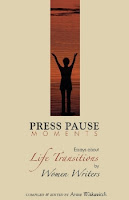 With "After the Sunflowers"
With "After the Sunflowers" Writing for an anthology is like soup in a can - concentrated. I lately had an essay published in the new anthology about women writers, Press Pause Moments: Essays About Life Transitions by Women Writers. I plant the writing wanted list in Poets & Writers Classifieds - a great resource, as is the literary magazine database in the Tools for Writers section (and the directory listing for writers under Connect With Others).
Here's a step-by-step access to how I addressed the cry for writing, particularly for an anthology.
I knew I had a scene at inclusion in the Press Pause project because the topic - transitions in the lives of women writers - resonated. So I wasn't trying to pull myself into a writing slot that didn't fit. I had too recently written several newspaper articles that could fit the topic. So there was a level of solid ground from the get-go.
Another plus factor was time. Editor and project coordinator Anne Witkavitch had given several months of run time for the submission deadline. So I had a prospect to carefully (and I mean carefully) consider the issue and cunning a man I could put away and fiddle with. Since my submission was on the 10-plus years it took to get an Italian citizen, I couldn't cover such a long transition in the allotted space and time. So, I opted for one scene of the action that would represent the total experience - a nerve-shredding series of visits to the Italian consulate in New York, one of which involved an armed carabiniere.I wrote the first drawing in one sitting, then put it aside. Over the following weeks, I revised, rewrote and reconstructed the draught to consolidate the history and excise extraneous information. I then put it away again, leaving it in my pending folder where I could be irritated by it on a steady basis (I hate stuff hanging about in to-do limbo).After another week I repeated the process, ever aware of the design guidelines and continually asking myself what I brought to the compilation that would be different from other writers. The issue was "Later the Sunflowers," whose style is still more bittersweet now (more about that later).Now that there are more calls for anthologies, consider these tips as you prepare and take your work: - Use a trusted resource, and do the due diligence in researching the anthology. Not all that glitters _
- Look for a subject and anthology that resonate with you, preferably on a topic you've written about before, or one you've ever wanted to save about.
- Look for a name with a long enough lead time, and set up a timeline for when you'll write, edit and revise.
- Consider whether photos, voice or video would raise the submission, or are needed for it.
- If you're addressing a subject that took awhile, consider selecting one typifying event or occurrence to ponder the whole.
- Frame your pick from the position of the singular characteristics you get to the history and compilation.
- Write the first drawing in one sitting, then put it aside.
- Don't scrimp on revision, even if it means a revision and reordering the story (but observe the first draft as a class file).
- Repeat the alteration process until you see yourself changing the like words back and forth.
- Extra tip: Make certain your source is fascinating and that your conclusion is satisfying. The end of my piece took longest to write.
No comments:
Post a Comment